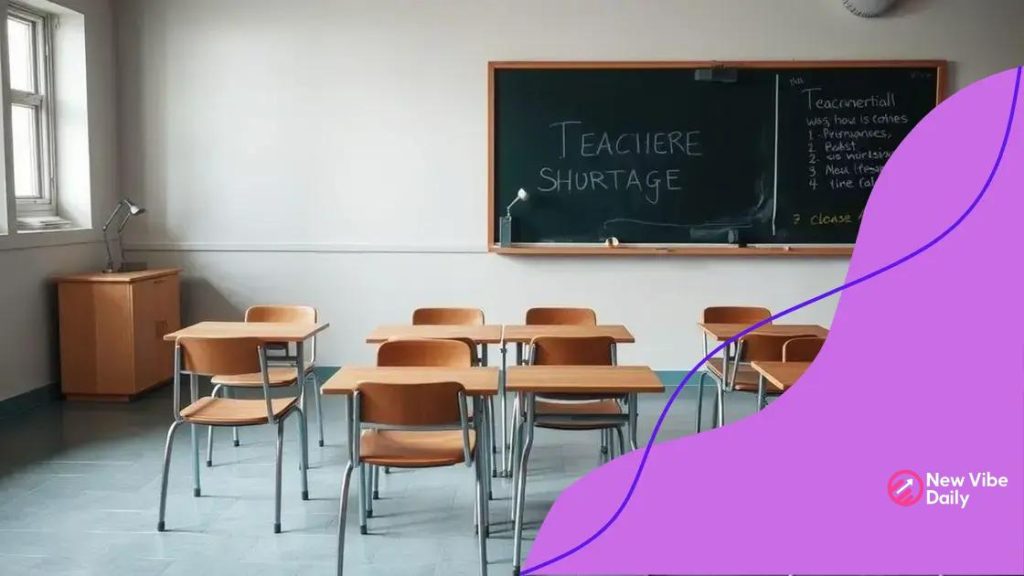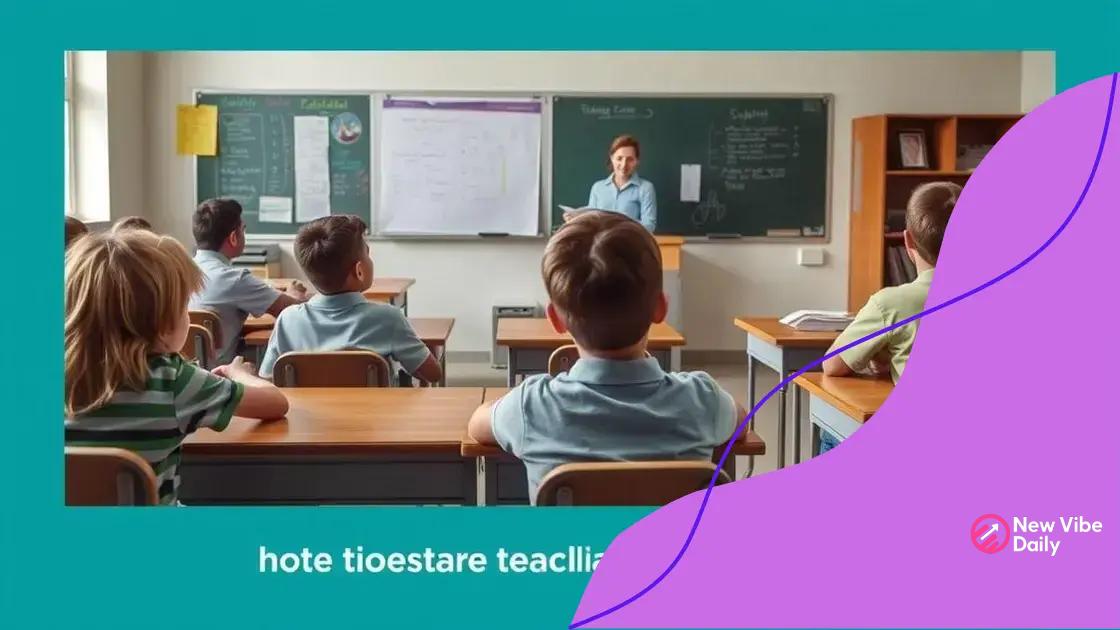Addressing the shortage of substitute teachers effectively

Addressing the shortage of substitute teachers requires improving pay, providing training, fostering positive relationships, and implementing flexible scheduling to create a sustainable and effective solution for schools.
Addressing the shortage of substitute teachers is becoming increasingly critical in our educational landscape. With schools struggling to fill temporary positions, it’s essential to explore effective strategies to ensure that learning continues without disruption. What can be done to support both educators and students during these challenging times?
Understanding the shortage of substitute teachers
Understanding the shortage of substitute teachers is essential to addressing the challenges within our educational system. This shortage is not just a statistic; it impacts students, teachers, and the overall learning environment. As schools face a growing need for substitute educators, knowing the reasons behind this issue can help in creating effective solutions.
One significant factor contributing to the shortage of substitute teachers is the low pay. Many substitutes earn less than their full-time counterparts, making the role less appealing. Additionally, the lack of adequate training and support can deter potential substitutes from entering the field. Further, the unpredictable nature of substitute teaching can also be a disincentive for many.
Reasons Behind the Shortage
- Low compensation: Many substitutes are paid very little, making it challenging to justify the demands of the job.
- Lack of training: Without proper orientation and training, substitutes may feel unprepared to handle classrooms effectively.
- Job instability: The absence of guaranteed work can discourage people from pursuing substitute teaching positions.
Furthermore, the ongoing impact of the COVID-19 pandemic has exacerbated this issue. Many teachers left the profession during the pandemic, leading to a greater demand for substitutes amid an already tight labor market. This urgency calls for immediate attention and strategic planning to attract more individuals to consider substitute teaching as a viable career option.
Impact on Education
The shortage of substitute teachers significantly affects educational quality. When there are not enough substitutes available, teachers may feel pressured to come to work even when ill, which can lower the overall effectiveness of instruction. Moreover, students potentially lose valuable learning opportunities when classes cannot be covered adequately.
To combat this shortage, schools and districts must develop attractive recruitment strategies. These strategies could include increasing pay, providing benefits, and offering flexible scheduling options. Encouraging retired teachers or college students in education programs to consider substitute teaching may also generate interest.
Factors contributing to the shortage
Many factors contribute to the shortage of substitute teachers, making it crucial to understand the complexities behind this issue. One major factor is the low pay that substitutes receive. Many people feel that the compensation does not reflect the demands of the job, leading to fewer individuals willing to take on these roles.
In addition to compensation, the lack of support and training for substitutes plays a significant role. Substitutes often walk into classrooms without sufficient preparation or guidance, which can create a frustrating experience for both them and the students. This can deter qualified individuals from pursuing substitute teaching as a viable option.
Key Factors Contributing to the Shortage
- Inadequate pay: Many substitutes earn significantly less compared to other teaching positions, impacting their willingness to work.
- Lack of training: Without proper orientation and resources, substitutes may feel unprepared for the classroom environment.
- Job instability: The unpredictable nature of substitute work can be a barrier for many potential candidates.
Another significant factor is the perception of substitute teaching as a less desirable job. Many view it as a temporary position lacking the stability and benefits of full-time teaching roles. This mindset can prevent skilled educators from stepping into the substitute role, especially when they have concerns about job security or professional growth.
Additionally, the demands of maintaining classroom behavior without a permanent teacher can be intimidating. Substitute teachers often face challenges when it comes to managing students and keeping them engaged, which can be stressful without adequate support.
Impact of the shortage on students and schools

The impact of the shortage of substitute teachers is felt deeply by both students and schools. When there are not enough substitutes available, schools struggle to maintain a consistent learning environment. This instability can lead to significant disruptions in the educational process.
Students are affected in multiple ways. In classrooms without a substitute, students may be left unsupervised, which can disrupt their learning and behavior. Additionally, when students have a different substitute teacher each time, they miss out on building a relationship with a consistent authority figure, which is crucial for their emotional and social development.
Effects on Students
- Disrupted learning: Without proper supervision, students may fall behind in their studies.
- Behavioral issues: Lack of consistent authority can lead to increased disruptions and chaos in the classroom.
- Emotional challenges: Students may experience feelings of instability and anxiety due to frequent changes in teachers.
Furthermore, the impact on schools can be severe. Schools may face increased stress on their full-time teachers, who might have to cover additional classes. This can lead to teacher burnout and lower morale among staff. Additionally, schools could suffer from a negative reputation if they consistently have poor coverage for absent teachers.
Schools that struggle with a lack of substitutes might also face challenges in meeting educational standards. Without experienced replacements, lesson plans may go unfulfilled, and essential instructional time can be lost. This can adversely affect the school’s overall performance and accountability ratings.
Innovative solutions for attracting substitute teachers
Finding innovative solutions for attracting substitute teachers is essential for addressing the ongoing shortage in schools. Schools must think creatively to entice individuals into this vital role. One effective approach is to improve compensation packages for substitutes. Offering competitive pay can make the position more appealing to prospective candidates.
Furthermore, providing professional development opportunities is another innovative strategy. When substitutes receive training and resources, they feel more prepared and confident in the classroom. This can lead to a more fulfilling experience, which may encourage them to return for future assignments.
Creative Strategies to Attract Substitutes
- Enhanced compensation: Increasing pay for substitutes can significantly increase interest in these positions.
- Flexible scheduling: Allowing substitutes to choose their workdays can make the role more attractive.
- Mentorship programs: Pairing new substitutes with experienced teachers can offer support and encouragement.
Additionally, creating a positive culture around substitute teaching is crucial. Schools can celebrate substitutes by recognizing their contributions publicly and providing feedback. This sense of community can motivate substitutes to continue working in schools.
Engaging local universities and colleges may also yield results. By establishing partnerships with education programs, schools can encourage students to consider substitute teaching as a stepping-stone in their careers. This connection not only helps schools find eager substitutes but also provides valuable classroom experience for students.
Future considerations for sustainable substitute teaching
Future considerations for sustainable substitute teaching involve looking at long-term strategies that can ensure a steady supply of qualified substitutes. As the demand for substitutes continues to rise, schools must adopt innovative approaches to maintain a healthy and effective workforce.
One important factor is fostering a positive relationship between full-time teachers and substitutes. Schools can create an environment where substitutes are seen as valuable members of the educational community. When substitutes are welcomed and supported, they are more likely to return for future assignments.
Strategies for Sustainability
- Regular training sessions: Providing ongoing professional development helps substitutes stay informed and engaged.
- Community engagement: Involving local organizations can help generate interest in substitute teaching.
- Feedback systems: Establishing mechanisms for feedback allows substitutes to share their experiences and suggestions for improvement.
Another critical aspect is ensuring flexible work options that appeal to a broader range of individuals. By offering flexible hours and the ability to choose assignments, schools can attract more people to the role of substitute teacher. Additionally, marketing these positions as opportunities for career growth and professional experience can entice prospective substitutes.
Building strong partnerships with schools of education will also play a vital role. Colleges and universities can help identify potential substitutes and facilitate their entry into the field. Internships or practicum experiences for education students can serve as a way to introduce them to substitute teaching and its benefits.
In conclusion, addressing the shortage of substitute teachers requires a comprehensive approach. By enhancing compensation, providing proper training, and fostering a positive environment, schools can make substitute teaching a more appealing option. Creative strategies like flexible scheduling and partnerships with local educational institutions can further attract and retain quality substitutes. As we look to the future, focusing on sustainable practices will help ensure that schools have the support they need to maintain a stable learning environment for all students.
FAQ – Common Questions About the Substitute Teacher Shortage
What are the main reasons for the shortage of substitute teachers?
The main reasons include low pay, lack of training and support, job instability, and negative perceptions of the role.
How can schools attract more substitute teachers?
Schools can attract more substitutes by increasing compensation, offering flexible scheduling, providing training, and fostering a supportive environment.
What impact does the shortage of substitute teachers have on students?
The shortage can disrupt learning, lead to behavioral issues, and negatively affect students’ emotional well-being due to inconsistent supervision.
What strategies can ensure sustainable substitute teaching in the future?
Creating partnerships with educational institutions, offering continual training, and recognizing substitutes’ contributions are key strategies for sustainability.






